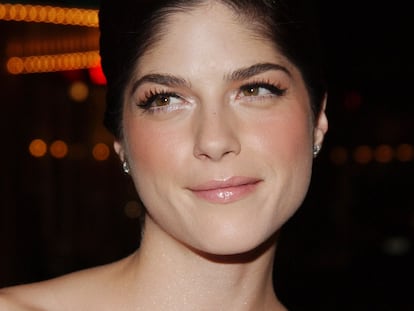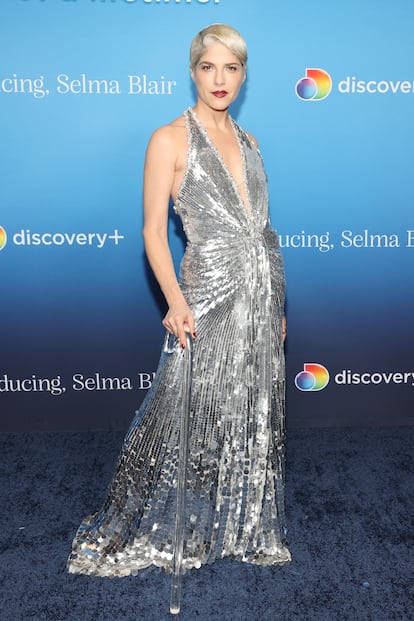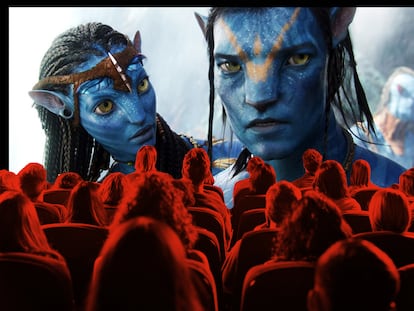Selma Blair: The star who danced through multiple sclerosis and brought Hollywood to its feet
The actress, known for her roles in groundbreaking teen movies, has published a tell-all memoir and earned praise for her recent performances on ‘Dancing with the Stars’

Selma Blair’s arrival on stage at the Microsoft Theatre in Los Angeles to present the final award at the most recent Emmy gala earned the biggest ovation of the night. She wasn’t receiving an Emmy; she wasn’t even nominated. She’s not a Hollywood legend, and most viewers can probably only recognize her from three or four movies. Nor did her presence on stage represent a reappearance after a long forced or voluntary absence. On the contrary, since she was diagnosed with multiple sclerosis four years ago, Blair, 50, has had a greater media presence than ever.
Most recently, US television viewers were able to watch Blair the new season of Dancing with the Stars. During one of her performances, she surprised the audience by dancing blindfolded. Her participation delighted everyone. “I am thrilled to learn how to move my body better right now, I am thrilled to have support, be here - have camaraderie,” she told Good Morning America. “I cannot believe that I am ready in my life to do this. I am so excited ... this is so powerful to me.” Her reason for appearing on the show was clear: “We do these things we want to find joy in. And then I’m all in.” For her debut, she arrived on stage in a flowing dress, sporting platinum hair that helps disguise bald patches from alopecia caused by her illness, with her ubiquitous cane in tow. Scout, Blair’s service dog, watched Selma from backstage. After her performance, there wasn’t a dry eye in the house. Social media went crazy for her. “Stay strong and keep doing what you’re doing, you’re an inspiration to us all,” one Twitter user wrote. Celebrities like Michelle Pfeiffer joined the chorus of praise: “Icon, actress, poet, writer, philanthropist and now we add dancer to your long list of talents.... Selma Blair! You never cease to amaze me! Such an inspiration to the world. Left us all in a puddle of tears,” Pfeiffer posted on Instagram. Unfortunately, Blair was forced to withdraw from the show on October 17 due to health reasons.
She also had the support of her best friend, Sarah Michelle Gellar, with whom she shared one of the most iconic moments in 1990s cinema, their kiss in Cruel Intentions. A couple of years ago, MTV called it “the most legendary kiss of the last forty years,” and they reprised it in a pandemic version. Gellar missed the first Dancing with the Stars gala because of her daughter’s birthday, but they were both in the audience for the second one, crying and applauding their friend. It was but one of many demonstrations of their friendship: during the worst moments of her illness, Gellar was Blair’s main source of support; Gellar shopped for her, cooked for her and even organized a support network that included stars like Reese Witherspoon and Jaime King. “I hated having caregivers in my house… But my God, did they help me!” Blair told Variety. “If [Selma] was having a bad day I would come over and crawl into bed with her, and we would lie there for hours and watch HGTV ,” Gellar told Town & Country in 2021.
Blair first became aware that something was seriously wrong with her body during a Christian Siriano fashion show. “I walked that day in the show. [I was] noticing for first time [that] my leg was numb. When I first stepped out, I couldn’t feel the ground or [know] how to lift my left leg. My brain was trying to compute [it all] as I walked the runway, stunned.”
That wasn’t the only time that she couldn’t understand why her body and mind weren’t in sync. In 2016, she collapsed on a flight. Blair blamed the episode on mixing alcohol and medication, but her reaction - screaming in despair that someone was attacking her - led the media to speculate that she had mental problems. Now, Blair knows that it was another symptom of multiple sclerosis, but at the time she was simply living with pain that she had been experiencing for years.
“I’d compare myself to people,” she confessed to Variety. “I didn’t understand people didn’t hurt every day. I’ve hurt since I can remember.” The symptoms became more acute after she gave birth to her son Arthur in 2011. “I really couldn’t move. The pain was so intense in every joint, in my hip, everything.” She blamed herself: “How am I such a weak lazy-ass that I can’t handle what every mother does?” Her physical deterioration had become so apparent that one day she received a call from her friend, actress Elizabeth Berkley, the star of Showgirls. Berkley insisted that Blair see her brother, a neurologist.

On October 20, 2018, she wrote a message on Instagram in which she announced her illness: “I am disabled. I fall sometimes. I drop things. My memory is foggy. And my left side is asking for directions from a broken gps. But we are doing it. And I laugh and I don’t know exactly what I will do precisely but I will do my best. Since my diagnosis at 10.30pm on the night of August 16, I have had love and support from my friends.” She’d just received a diagnosis of multiple sclerosis, a chronic degenerative disease that affects the brain and spinal cord. As Blair put it, the ailment is like “a snowflake,” because it presents differently in each person, which makes the disease very difficult to diagnose. It’s likely that she had been suffering from multiple sclerosis for over a decade, but her doctors had always downplayed her symptoms and attributed them to the licentious life of movie stars or the fatigue of a single mother. They attributed her anxiety and memory loss to work-related stress.
After her diagnosis, she underwent various treatments, but they did not alleviate her symptoms. Then Hollywood - a community sometimes seen as cold, envious, and unsupportive - worked its magic. Jennifer Grey, the actress who played Baby in Dirty Dancing and whom Blair barely knew, contacted her about a treatment for autoimmune diseases at Northwestern University and helped her get into the program, as Blair recalls in her powerful memoir Mean Baby: A Memoir of Growing Up.
The road ahead of Blair was not going to be easy. Her career hadn’t been easy, either. She didn’t get her first major role until she was 26. Just as she was beginning to consider returning home to Michigan, she landed the role of Cecile in Cruel Intentions (1999), a teen version of Dangerous Liaisons. “I was the oldest in the cast but newest to the industry. I had auditioned for, like, 60 things… and didn’t get them because I was over 18.” When director Roger Kumble asked her how old she was, Blair retorted: “How old are you?” That determination won her the part.
In 2001, Blair once again shared the screen with her Cruel Intentions co-star, Reese Witherspoon, in Legally Blonde. The film gave us a glimpse of Blair’s comedic chops, which were on full display in the raunchy comedy The Sweetest Thing (2002), where Blair shared the lead with Cameron Diaz. Then she moved on from teen movies. Before stars started jostling for roles in superhero blockbusters, she played Liz Sherman, the powerful girlfriend in Guillermo del Toro’s Hellboy. But Blair’s independent film performances are the most interesting part of her career. She broke with her image as a giddy friend by teaming up with then-enfant terrible Todd Solondz in Storytelling (2002) and Dark Horse (2011), movies geared more toward film festivals than teenagers. In those movies, she proved to be a daring actress. She also caught the attention of director John Waters, who gave her the role of Ursula Ubres, the huge-breasted exhibitionist in A Dirty Shame (2004), the director’s last film.
Blair didn’t make headlines for her performances alone, although she probably would have preferred it that way. She was also one of the most visible faces of the MeToo movement. As she revealed in Vanity Fair, she was one of dozens of director James Toback’s victims. Blair met Toback before she had landed a major role, and he was an Oscar-winning screenwriter about to begin production. Following a sadly familiar modus operandi, Toback faked a last-minute setback to lure her to his room; once she was there, he asked her to strip. “Why does my character have to strip? She’s a lawyer in a courtroom,” Blair protested. “Because I need to see how you move. How comfortable you are with your body.” He tried to have sex with her, and she refused. Toback then “settled” for rubbing himself against her leg while looking into her eyes. Terrified and alone, Blair resigned herself out of fear that he’d rape her. Before she left the room, Toback threatened that if she said a single word, someone would kidnap her and throw her into the Hudson River with cinderblocks on her feet.
But no film has been more important to Blair than Rachel Fleit’s documentary Introducing, Selma Blair (2021), in which she recounts her life following her decision to undergo a risky stem cell transplant. Doctors warned her that she could die during the two-month-long procedure, which includes intensive chemotherapy that reduces the immune system to one percent of its normal function. She decided to do the documentary because of her son Arthur. “He’s had to endure a lot; he’s seen a lot,” she told People. He has been the main witness of her physical deterioration, inability to speak and countless falls. “Mommy’s not sick, Mommy’s brave,” he would tell her. But Arthur didn’t want Blair to participate in the documentary. “He was worried that people would see me this way and talk behind my back or not give me a job.” That’s not entirely off the mark. As Blair recently told The New York Times, “The parts that I’m offered since I’ve had my diagnosis are the old woman, the person in the wheelchair, the person bumping into walls… I might be those things, but I’m still everything else I was before, and I shouldn’t be relegated to that.”

Gellar was also skeptical about the documentary. “[Blair] would say, ‘God forbid, if I don’t make it, then Arthur has a whole video diary of what I went through. He’ll never have to wonder, did I give up? He’ll know how hard I fought to be there for him.’” Blair’s willpower is evident to anyone who watched her do cartwheels on Dancing with the Stars.
There is not a hint of vanity in Fleit’s film. Blair never tries to hide her symptoms or appeal to glamor. The moments she and her son share are the most touching scenes in the documentary. For instance, she allows Arthur to help shave her head before chemotherapy, a way to make a traumatic process more fun. It was important to Blair that the documentary serve as inspiration for those who are experiencing something similar. Indeed, her first words in the film are a declaration of intent. “We have a long time to be dead and I spent so long trying to kill myself or numb myself or check out or figure out how to be alive by being half dead, and now I just want to help other people feel better.”
Tu suscripción se está usando en otro dispositivo
¿Quieres añadir otro usuario a tu suscripción?
Si continúas leyendo en este dispositivo, no se podrá leer en el otro.
FlechaTu suscripción se está usando en otro dispositivo y solo puedes acceder a EL PAÍS desde un dispositivo a la vez.
Si quieres compartir tu cuenta, cambia tu suscripción a la modalidad Premium, así podrás añadir otro usuario. Cada uno accederá con su propia cuenta de email, lo que os permitirá personalizar vuestra experiencia en EL PAÍS.
¿Tienes una suscripción de empresa? Accede aquí para contratar más cuentas.
En el caso de no saber quién está usando tu cuenta, te recomendamos cambiar tu contraseña aquí.
Si decides continuar compartiendo tu cuenta, este mensaje se mostrará en tu dispositivo y en el de la otra persona que está usando tu cuenta de forma indefinida, afectando a tu experiencia de lectura. Puedes consultar aquí los términos y condiciones de la suscripción digital.
More information
Últimas noticias
New York enters the era of Zohran Mamdani
Welcome to the post-religion era: The idea of Christianity as the absolute truth has become obsolete
‘I thought you would like it’: The risky sexual practice popularized by TV shows and TikTok
The digitalization of tourism: ‘They promise experiences and gave us the worst possible one’
Most viewed
- Sinaloa Cartel war is taking its toll on Los Chapitos
- Reinhard Genzel, Nobel laureate in physics: ‘One-minute videos will never give you the truth’
- Oona Chaplin: ‘I told James Cameron that I was living in a treehouse and starting a permaculture project with a friend’
- Why the price of coffee has skyrocketed: from Brazilian plantations to specialty coffee houses
- Silver prices are going crazy: This is what’s fueling the rally











































